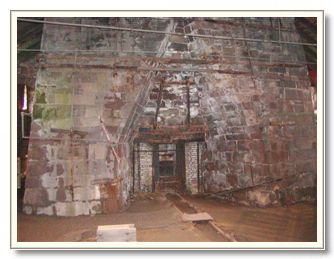Peter Grubb was searching for a source of building stone in the mid 1700s. What he discovered was the richest deposit of iron ore in the western hemisphere. It continued to produce ore for a variety
of companies until it was eventually closed by Bethlehem Steel in 1976. By this time the famous deposits of the Mesabi Range were discovered and those of Cornwall PA were no longer commercially viable to
recover.
Cornwall Furnace stands nearly intact today as it was in the 1700s
when it was built. It is the most complete example of the early iron blast
furnaces
from Colonial America.
Coke and Ore Storage Bins
This is the working end of the Furnace. The molten iron is tapped here and it flows
along the trough in the floor to molds, or "pigs" buried in
the sand of the floor. Hence the term,
Pig Iron.
This 24-foot diameter wheel was turned, originally by water power, and
later by steam, generated from the heat of the blast, to operate air pistons to
force air to the furnace.
An old road sign pointing to the site.
The middle part of the picture shows the exterior of the blast
furnace. It is 30 feet high and can be
accessed at top to load the ore, coke and limestone, and at the bottom to
remove the slag and molten iron.
Molten iron flows through this trough to the pigs in the floor.
This is the Paymaster's house which sits close to the furnace. A welcome site to the workers whose 12 hour
shifts and only 2 days off per month earned very little for their toil.
This steam engine replaced the water wheel to operate the air pumps
for the blast. It is powered from the black
pipe which carries steam generated by the excess heat of the furnace.
The original wooden axle of the Great Wheel was bent by the weight of
the wheel from sitting idle for many years when the state took over the
site. A rebuilt axle is in place to
allow the Great Wheel to rotate today.











No comments:
Post a Comment